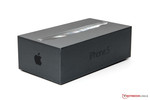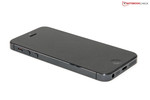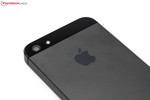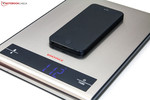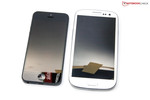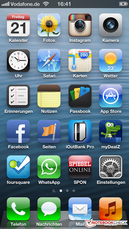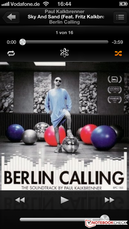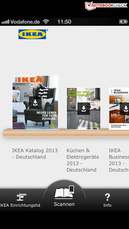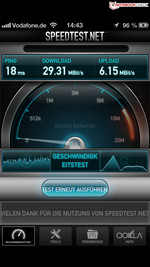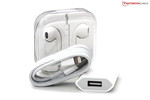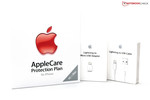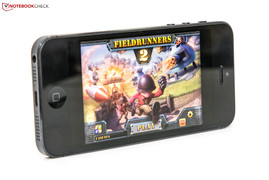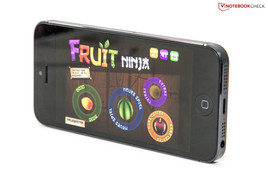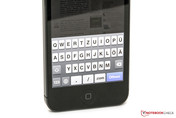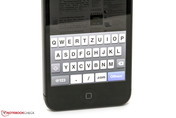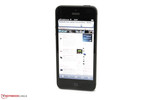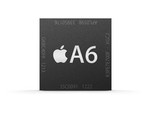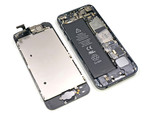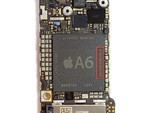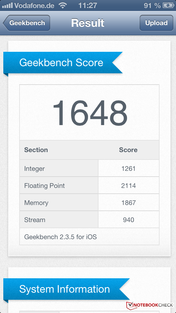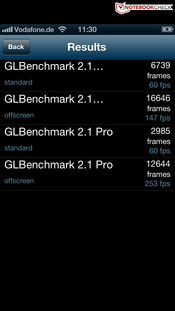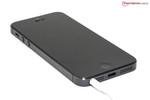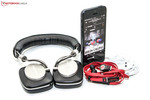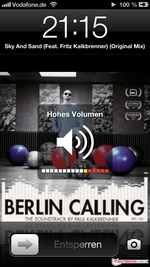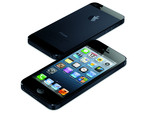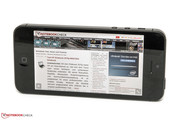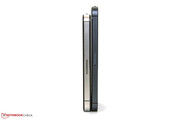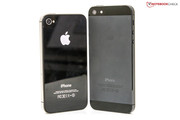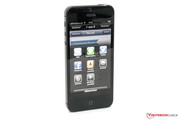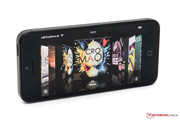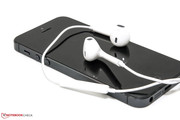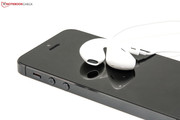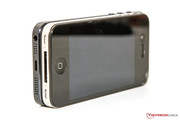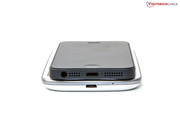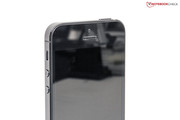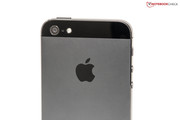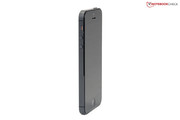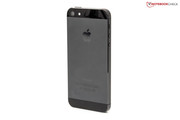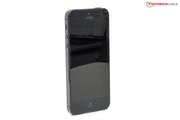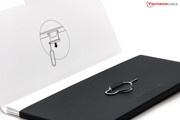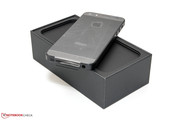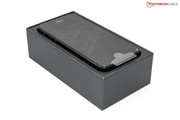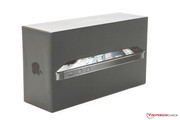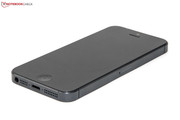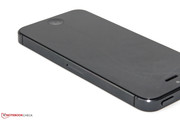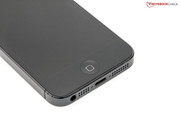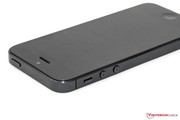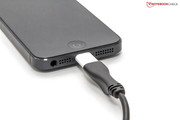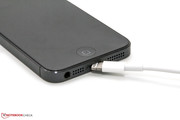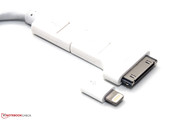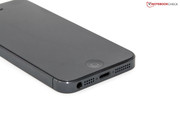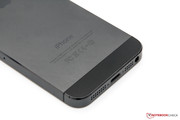Review Apple iPhone 5 Smartphone

Apple introduced the iPhone 5 at a special event on September 12. In the run-up, various rumors were circulating concerning possible features and the final design. In the end, almost all the leaked information and pictures turned out to be correct. The sixth generation of the smartphone from Cupertino is clad in a very slim unibody case made from aluminum, which measures only 7.6 millimeters (0.3 inches) in thickness. It is again available in black and white, but details in the design differ from the predecessor. Other highlights include the larger Retina display with a 4-inch diagonal (1136x640 pixels), the powerful Apple A6 chip, and the new Lightning Connector. The often-rumored "killer feature" was absent, another reason why the iPhone 5 divides opinion. Instead, Apple has concentrated on fine-tuning in those areas that many users had expected in the iPhone 4S.
As usual, the memory is fixed in the case, leaving the buyer to choose 16, 32 and 64 GB options. Among the many small changes are the camera modules with 8 megapixels at the back and 1.2 megapixels at the front, the placement of the audio jack, an improved speaker, and the bundled EarPods. The term "Ultrafast Wireless" covers WLAN and Bluetooth 4.0, as well as LTE (Long Term Evolution), although its use in Germany is limited to T-Mobile's network. The smartphone comes with iOS 6 preinstalled, which includes several improvements. Among these, there's a native mapping application, panorama capture mode, Passbook for tickets and vouchers, and an updated version of the Siri voice assistant. The slim package is capable of up to eight hours of 3G talk time, according to Apple. Prices start at 679 Euros (~$876 MSRP) without a contract, 50 Euros (~$64) more than the predecessor.
Case
Apple has clad the iPhone 5 in a completely redesigned case, although the basic shape bears a clear resemblance to the iPhone 4S. The new case is an elegant unibody chassis, machined from a single block of aluminum. As before, there's the choice between two color options: "black & graphite" and "white & silver". Apple has followed the example of its laptop design, and fitted the back with a wide insert made of anodized 6000 aluminum. The back side is completed by two inlays of glass ceramics (white) or pigmented glass in the black variant. Apple showcases parts of the manufacturing process in a promotional video. Apple claims to achieve the highest possible degree of precision, and a corresponding choice of materials.
In practice, the case leaves a positive impression throughout. High-quality workmanship is evident, uneven clearances or creeks were not detectable. Torsion from two hands is no problem for the unibody. Of course, in everyday situations, a little more caution is advised than for a device without glass elements. The keys also give a good impression. The separate volume control keys provide clear feedback, and blind operation is easy. The term ScuffGate has made the rounds on the Internet, showing black devices with visible manufacturing faults. We did not detect any of these problems in our two test samples.
With a total weight of just 112 grams (0.25 pounds), the new smartphone now weighs 20 percent less than its predecessor, and at just 7.6 millimeters (0.3 inches) in thickness, it is also 18 percent thinner. When compared directly (and subjectively) to the previous generation, and to Samsung's Galaxy S3, the iPhone 5 appears very light and slim. Apple themselves speak of the world's thinnest smartphone, although several models are available on the Asian market that are even slimmer. Still, considering the wireless capabilities, the iPhone 5 is probably the thinnest LTE smartphone in the world today.
Features
Connection options remain at a bare minimum. The 3.5 mm headphone jack has been moved to the underside in the latest incarnation. In practice, the cable now no longer gets in the way of the user. Another innovation concerns the dock connector. After almost 10 years, Apple has completely redesigned the 30 pin socket, and calls the new version Lightning. The new port has shrunk by 80 percent, can be connected regardless of orientation, and has become fully digital (8 signal design). In addition, the durability is said to be improved. Contrary to what the name suggests, the interface only offers USB 2.0 performance. Adapters are available for older cables and accessories, but these have to be purchased separately. On its US website, Apple writes that the new Lightning port no longer supports "iPod out". Control via corresponding in-car systems appears to be impossible in the future.
Software
The new iPhone ships with iOS 6 pre-installed. Visually, there isn't much of a difference awaiting the user. Apple's own applications have been adapted slightly. By its own claims, the maker of the iOS has also integrated more than 200 new features into the mobile operating system. One key point of the update is the native mapping application, but it's not off to a good start, due to a multitude of errors. Google has already submitted its own application to the App Store, and together with YouTube, it is awaiting approval by Apple. Apart from the usual features, Maps now also includes the possibility of turn-by-turn navigation, local searches, and traffic information. However, not all aspects of iOS 6 are available in the German market. The 3D visualization of buildings in Maps shown in the presentation, the booking of tables in restaurants, or the display of movie reviews along with their running time via Siri have not been implemented for Germany. Other parts of the voice control have been revised, and it is now capable of processing additional commands. An overview of the functions, and their country-specific availability, can be found here.
Some of the other innovations include the integration of Facebook into the OS, the Passbook app for tickets and vouchers, the possibility of using FaceTime on the go, a VIP Inbox in Mail, and the option of using Safari in fullscreen mode. These features, as well as the refusal of calls with a predefined message or the panorama picture mode mark minor improvements, that Android users probably sneer at. All these have been available under Android since version 4 (Ice Cream Sandwich, ICS) for over a year, as well as through third-party apps under iOS.
In everyday use, the operating system performs well. iOS 6 runs very smoothly, and loading times are short. One reason for this lies in Apple's specifications for developers, as well as the manageable range of devices. In the Android universe, there are a plethora of configurations and software versions, that all need to be taken care of. On the iPhone 5 in particular however, there are currently some applications that haven’t yet mastered the high resolution display. Compared to the iPhone 4S, there are 176 additional pixels in the vertical, leading to letterboxing with black bars on some applications. The app itself is centered, and the black areas are evenly distributed above and below, or to the left and right in landscape mode. In the image gallery, you will find several examples of applications that currently run with letterboxes.
Communication & GPS
At first glance, the iPhone 5 now offers all current mobile technology, marketed under the "Ultrafast Wireless" slogan. At the heart of the concept we find a single-chip solution coupled to four dynamical antennae, marked out by the narrow horizontal lines on the chassis. Switching is done automatically, depending on application and signal.
Communication options start with Wi-Fi according to 802.11 a/b/g standard, as well as Dual-Band 802.11n (2.4 und 5 GHz) with a maximum transfer rate of 150 Mbit/s. Together with Bluetooth 4, this puts the smartphone on par with comparable Android devices. For the first time on an iPhone, there is also Long Term Evolution, or LTE (4G) for short, with a chip that only transmits at one of the three frequency bands available in Germany, 1800 MHz. The bands at 800 and 2600 MHz are not covered. This gives T-Mobile a factual monopoly, since neither Vodaphone nor o2 possess the corresponding licenses. The E-Plus group has not yet established its own LTE network, although it could access the frequency range in use. Existing Telekom customers will have to subscribe to an additional plan called "Speed Option LTE", at an extra cost of 9.95 Euros (~$13) per month. With this plan, up to 100 Mbit/s are promised, which exceeds the bandwidth of many DSL lines. Users of other wireless networks will have to contend with HSPA+ (High Speed Packet Access) and a top speed of 21 Mbit/s.
In Germany, the iPhone 5 is offered as a GSM model with the type designation A1429. It supports the four principal GSM frequencies, 850, 900, 1800, and 1900 MHz (Quad-Band), which makes the smartphone compatible with most networks worldwide. Comparable devices such as the Samsung Galaxy S3, the HTC One X or the Nokia Lumia 920 also supports this technology, with HTC and Samsung only offering an LTE version after the initial release. The Nokia Lumia 920 with Windows Phone 8 will be the first smartphone to support all LTE frequencies (Peta-Band Chip) from launch. Apple takes a pass on Near Field Communication (NFC). This short-range communication system would enable contactless payments via credit card, or opening the locker in the gym.
Already today, many applications make use of a smartphone's location information. The Apple iPhone 5 offers A-GPS as well as GLONASS. We checked the function using the MotionX-GPS app. Outside as well as indoors, it took only a few seconds until our position data was displayed on the map.
Phone Functionality
The telephone app is one among the many icons on the first home screen, and is preconfigured to take its permanent place on the lower left, among the often-used applications. Overall, the application has received a facelift in iOS 6. Phone numbers in Safari or Mail can still be dialed directly from the respective app, after confirmation by the user. A new feature is the possibility to refuse a call using a predefined message. This function has long existed on Android devices and turns out to be quite useful in situations like driving a car, or sitting in lectures.
Cameras & Multimedia
Two cameras, that's no surprise. And the fact that the front camera would see an upgrade over its predecessor was also expected given the strong emphasis of FaceTime at Apple. In pure numbers, that means the continuation of an 8 Megapixel sensor at the back, and a model with 1.2 instead of 0.3 Megapixels in the front. The front camera is now capable of recording videos at 720p resolution, while the back camera had been capable of FullHD for some time. The really interesting innovations are "under the hood". Apple promises a 40 percent reduction in shutter lag, an optimized light sensitivity for better images in low-light conditions, and an improved image stabilizer for video recording. The new lens made from clear sapphire glass is also designed to better capture photographic details. Amongst the other new features, there's a panorama mode, which has also been brought to older devices along with the iOS 6 upgrade, and face recognition for up to 10 faces.
We can confirm that photos under diffuse light are better than they were on the iPhone 4S. Apple also has not exaggerated its claim regarding the shutter lag. Overall, pictures look a touch more colorful and sharper than on the predecessor. As before, we cannot advise to use the digital zoom, however. The results are blurred and strongly pixilated.
Usage of the panorama mode has been designed very intuitively by Apple. An arrow on the display indicates at which height the phone should be held, and how fast it has to be moved in a clockwise direction, in order to achieve an optimal result. And the pictures that can cover up to 240 degrees are impressive indeed. The quality strongly depends on the photographer keeping a steady hand. A wavering or too quick movement causes artifacts and image transitions that don't always match.
The image stabilization in video mode works even better than on the iPhone 4S. Quite remarkable results are possible, even when your hand isn't perfectly still. The improved light capture is clearly evident in low-light exposures. Videos also benefit from the stronger color rendering of the iPhone 5. For the first time, Apple has now integrated a function to capture photos during video shooting. In principle, that could be a useful feature - unfortunately though, these photos are not captured at the camera's native resolution. Instead, these are single movie frames, which are restricted to its FullHD resolution in 16:9 format. We were barely able to notice the increased quality and sensitivity of the built-in microphone that Apple has promised.
Thanks to the 16:9 aspect ratio, the iPhone 5 is finally able to display HD videos without horizontal letterboxing, which simply looks much better, and ads to the enjoyment of watching videos. The new iPhone is not capable of playing the popular video container format .mkv, so a third party app is required.
Accessories
Inside the black box of our test model, we find the usual accessories. Besides the smartphone itself, Apple provides the new EarPods with cable remote control and microphone (headset), a USB cable for synchronization and recharging, a modular power adapter, several documentation papers and the obligatory Apple sticker. Additional accessories have to be purchased separately.
It's at this point where the Cupertino company is looking to line its pockets, because the new Lightning Connector is a proprietary format. Older or different cables and docks can only be used with the appropriate adapters. The 30 pin connector of the earlier generations requires a 29 Euro (~$37) part (39 Euros/~$50 with a 0.2 meter/~7.9 inch cable). Much more controversial will be the Lightning-to-Micro-USB adapter that's also available. In 2009, the European Union (EU) had passed a directive together with Apple, Motorola, Nokia and RIM, according to which new devices have to be rechargeable and connectable independent of manufacturer. At the time, Micro-USB was chosen as the universal standard. With the new Lightning Connector, Apple appears to exploit this directive to its advantage, and cashes in on the 19 Euro (~$25) adapter in Europe.
On the other hand, Apple no longer offers a dock for the iPhone 5. A reader of 9to5Mac has contacted Phil Schiller, Apple's head of marketing and Senior Vice President (SVP) via email, who confirmed that there are currently no plans to make this type of accessory.
Warranty
Apple provides a manufacturer warranty of 12 months for the iPhone 5, including 90 days of free telephone support via Express Lane. For a surcharge, these services can be extended. The company itself offers the Apple Care Protection Plan (ACPP), which runs for 24 months, including telephone support. The warranty upgrade is available from Apple Stores for a price of 69 Euros (~$89 MSRP). Various resellers also offer their own service plans for the iPhone. In Germany, the so-called Gravis Hardware-Schutz (hardware protection plan) for iOS is available for about 50 Euros (~$65) (pro: 90 Euros/~$116), for example. Buyers of these plans are tied to the respective vendor, of course, if they need to make a claim.
Games
Due to the symbiosis of hardware and software, or simply due to the closed system, there is not much to report in this section. The integrated PowerVR SGX 543MP3 graphics play well with all games available on the App Store, whether it's simple titles like Doodle Jump, Risk, and Angry Birds, or more demanding 3D games such as Real Racing 2 and Infinity Blade. A temporary problem in many games that don't yet support the resolution of the iPhone 5 is caused by the black letterboxes. By force of habit, the user goes up to the edge of the display, which now only contain a black bar until the game is adapted. However, it should be only a matter of time until all apps have made the required change.
Input Devices & User Experience
The user interface on the iPhone 5 has not changed much compared to its predecessors. iOS 6 is available for all iPhones from the 3GS model upwards. The full functionality is reserved for the 4S and the new iPhone 5 models, however. But first, let's address the touch screen: it has become larger, taller to be precise. The width remains unchanged. That's so that your thumb can still reach the entire screen, according to Apple. That's right, according to us. Indeed, the 4-inch display leaves a positive impression, without bloating the Apple smartphone too much. It still feels compact and comfortable to hold, and can easily be controlled with one hand. The same cannot be said for the "smartphone giants", the Samsung Galaxy S3 and the HTC One XL - not to mention the 5.3 inch tall Samsung Galaxy Note N700.
The iPhone 5's touch screen reacts precisely and without any delay to touch and gestures. The marked increase in performance can be felt when opening apps, and when scrolling or zooming on websites. Apps now start up even faster, judders or delays during use are completely absent. Overall, the user interface is excellent, but apart from the faster app starts, not much has changed compared to the predecessor.
The possibility to display German Umlauts on the first level of the virtual keyboard is a feather in the cap of iOS 6. While this significantly increases typing speed in landscape mode, it can cause problems in portrait mode. The keys that were already small have been squeezed even further, which does not exactly help. On the contrary: our tester experienced an increase in typos. Whether the change from iOS 5.1.1 to iOS 6 simplifies the user experience comes down to a matter of taste. We believe it's a question of habit. But overall, iOS 6 does not pose any serious challenges. It's hard to imagine a smoother workflow than what the iPhone 5 provides - but the same is true for the latest generation quad-core competitors by HTC and Samsung.
The revised Retina display in Apple's iPhone 5 now spans 4-inches (10.16 centimeters) diagonally. In comparison to the iPhone 4S, the screen has only grown in height. Instead of the previous resolution of 960x640 pixels, the smartphone now offers 1136x640 pixels. This represents an additional 176 pixels in the vertical. On the other hand, besides a fifth row of icons on the home screen, the new format now offers a 16:9 aspect ratio. However, there's a catch: 720p videos with 1280x720 resolution cannot be displayed natively. Some competitors with Google Android or Windows Phone 8 support this resolution by default.
When it comes to pixel density, nothing has changed. At 326 DPI, single pixels are unrecognizable, and the image is sharp throughout. Especially compared to the older iPhone 3GS, the difference is clearly visible. On this model, colors appear muted, pixels are visible on closer inspection, and it looks like the screen is covered under a faint white veil. The hardware side of the screen also sees an update. The touch-sensitive component has now been directly integrated, saving one extra layer and allowing a reduction of the screen thickness by some 30 percent. In addition, the screen is said to produce fewer reflections, but more on that later. What are the promises that our measurements will check up on? Apple claims a contrast ratio of 800:1, and a convincing brightness of 500 cd/m².
Our first measurements appear to confirm or even slightly exceed the manufacturer's claims. With a maximum brightness of 499 cd/m², a high contrast ratio (1040:1), and a comparatively low black value (0.48 cd/m²), the screen is nothing to sneeze at. The illumination distribution is very even, at 95 percent. The image sharpness is very good, and colors come out clearly and vibrantly.
| |||||||||||||||||||||||||
Brightness Distribution: 95 %
Center on Battery: 499 cd/m²
Contrast: 1040:1 (Black: 0.48 cd/m²)
As the keynote speech progressed, an improved color space coverage was mentioned. With an increase of 44 percent compared to the iPhone 4 and 4S, the sRGB standard should now be covered completely. Unfortunately, we were unable to confirm this claim, which may be an important point for professional users intending to assess photos and videos on the go. Under normal conditions this "feature" is not noticeable.
The smartphone is well equipped for outdoor use, even though reflections are present. The brightness provided, coupled with a high contrast ratio, make for good rendering of images outdoors. When the luminosity is lowered, reflections caused by the glossy surface increase. The automatic brightness adjustment is advisable in these situations, and can be enabled in the settings. A matte screen protector may help, but given the good measurement results, there is not much need for it.
Performance
As we know, Apple has always shrouded itself in secrecy when it comes to the SoC (System-on-a-Chip) inside its iOS devices. The iPhone 5 is no exception, as the statement simply says: Apple A6. And, of course, the new version is supposedly twice as fast as the A5 chip of the predecessor. So far, the following facts seem assured: The chip is made in a 32 nanometer process. It is not only capable of the ARM-v7 instruction set, but also of a version called ARM-v7s. Parts of the v7s specification include the VFPv4 extension (Vector-Floating-Point). This also rules out the possibility that the A6 chip is based on ARM Cortex-A9 cores. The rumors that it features Cortex-A15 cores have likewise proven false. Inside the Cortex-A15, the extensions make use of a 32-bit register, whereas it’s only 16-bit on the A6. The most likely explanation is an in-house development from Cupertino. Whether Apple has said good-bye to Samsung as a chip manufacturer over the latest patent woes has so far not been confirmed. There are conflicting rumors on the issue.
The clock frequency no longer leaves room for speculation. Compared to the 800 MHz speed of the predecessor A4 and A5 chips, it has seen a boost. According to the experts at Anandtech, the CPU dynamically runs at frequencies between 800 and 1200 MHz, depending on load. The number of computing cores had also been a well-guarded secret. But it, too, has been revealed: the iPhone 5 remains a dual-core phone. The increase in performance is therefore due solely to the increased clock frequency, iOS 6, and the larger sized cores. Geekbench 2 reports 32 KB of both level 1 and level 2 cache. The size of the LPDDR2 RAM is one GB. The RAM chips are apparently no longer made by Samsung. According to Chipworks, modules made by Elpida are fitted instead.
The graphics setup had also been fueling rumors prior to the launch. The fact is that Apple continues to rely on a GPU made by Imagination. This time, it’s a PowerVR SGX 543MP3, a triple-core GPU with a clock speed of 266 MHz.
The relevant Benchmarks don't care about speculations; all they care about is tangible results. Geekbench 2 is one of the most popular synthetic benchmarks. And it attests to a huge performance gain relative to the iPhone 4S and the iPad 3. The sizeable margin in the overall score over these two Apple A5-equipped devices measures between 110 and 130 percent. Still, the iPhone 5 does not win the performance crown in terms of Geekbench 2 results. Among smartphones, the top spot is reserved for the Samsung Galaxy S3. The advantage of the Samsung powerhouse in the overall score in Geekbench 2 is gained chiefly in the raw computing speed during the integer and floating point tests. When it comes to memory bandwidth, on the other hand, Apple's iPhone 5 is head and shoulders above the competition. It's a similar picture in the Linpack test: the iPhone 5 does not only put its predecessor to shame, it also blows the combined smartphone and tablet elite out of the water. In the single thread test, for example, the Apple device achieves a score six times higher than that of the Galaxy S3.
In practice, browser-based tests are more relevant than the synthetic benchmarks. These also attest to the very high performance of the Apple iPhone 5 - especially compared to the 4S. What they also show, however, is that the competition does not have to run scared. While Apple's newest addition has a clear advantage in the Sunspider test, Samsung's flagship models are almost on par during the Browsermark, and even go ahead slightly in the Google v8 benchmark.
Last but not least, we'll have a look at the graphics performance of the new iPhone. For this purpose, we make use of versions 2.1 and 2.5 of the GL Benchmark. Both show the same result: In terms of graphics power, the iPhone 5 is currently without competition. Above all, the more challenging GL Benchmark 2.5 sends a clear message.
Apple has not promised too much when it comes to the performance boost of the new iPhone 5. On the contrary, some of the benchmarks see an even greater improvement relative to the iPhone 4S than the doubling of performance that Apple had forecast. What the benchmarks also show is that Apple has produced a winner with its iOS 6 in terms of performance. The iPhone 4S with iOS 6 benefits from a performance increase of about 15 percent compared to the same device running iOS 5 - quite remarkable. We are curious to see what the competition can come up with next. The Samsung Galaxy Note II, for example, is almost out of the blocks.
| Geekbench 2 - 32 Bit | |
| Total Score (sort by value) | |
| Apple iPhone 5 | |
| iPhone 4S iOS 6 | |
| Apple iPad 3. Gen 2012-03 | |
| Samsung Galaxy S3 | |
| HTC One X | |
| Integer (sort by value) | |
| Apple iPhone 5 | |
| iPhone 4S iOS 6 | |
| Apple iPad 3. Gen 2012-03 | |
| Samsung Galaxy S3 | |
| HTC One X | |
| Floating Point (sort by value) | |
| Apple iPhone 5 | |
| iPhone 4S iOS 6 | |
| Apple iPad 3. Gen 2012-03 | |
| Samsung Galaxy S3 | |
| HTC One X | |
| Memory (sort by value) | |
| Apple iPhone 5 | |
| iPhone 4S iOS 6 | |
| Apple iPad 3. Gen 2012-03 | |
| Samsung Galaxy S3 | |
| HTC One X | |
| Stream (sort by value) | |
| Apple iPhone 5 | |
| iPhone 4S iOS 6 | |
| Apple iPad 3. Gen 2012-03 | |
| Samsung Galaxy S3 | |
| HTC One X | |
| GLBenchmark 2.5 | |
| Egypt HD Fixed Time (sort by value) | |
| Apple iPhone 5 | |
| iPhone 4S iOS 6 | |
| Apple iPad 3. Gen 2012-03 | |
| Samsung Galaxy S3 | |
| 1920x1080 Egypt HD Offscreen Fixed Time (sort by value) | |
| Apple iPhone 5 | |
| iPhone 4S iOS 6 | |
| Apple iPad 3. Gen 2012-03 | |
| Samsung Galaxy S3 | |
| GLBenchmark 2.1 | |
| Egypt Offscreen (720p) (sort by value) | |
| Apple iPhone 5 | |
| iPhone 4S iOS 6 | |
| Apple iPad 3. Gen 2012-03 | |
| Samsung Galaxy S3 | |
| HTC One X | |
| Pro Offscreen (720p) (sort by value) | |
| Apple iPhone 5 | |
| iPhone 4S iOS 6 | |
| Apple iPad 3. Gen 2012-03 | |
| Samsung Galaxy S3 | |
| HTC One X | |
| Google V8 Ver. 6 - --- (sort by value) | |
| Apple iPhone 5 | |
| iPhone 4S iOS 5 | |
| iPhone 4S iOS 6 | |
| Apple iPad 3. Gen 2012-03 | |
| Samsung Galaxy S3 | |
| HTC One X | |
| Google V8 Ver. 7 - Google V8 Ver. 7 Score (sort by value) | |
| Apple iPhone 5 | |
| iPhone 4S iOS 5 | |
| iPhone 4S iOS 6 | |
| Apple iPad 3. Gen 2012-03 | |
| Samsung Galaxy S3 | |
| HTC One X | |
| Browsermark 1.0 - --- (sort by value) | |
| Apple iPhone 5 | |
| iPhone 4S iOS 5 | |
| iPhone 4S iOS 6 | |
| Apple iPad 3. Gen 2012-03 | |
| Samsung Galaxy S3 | |
| HTC One X | |
| Sunspider - 0.9.1 Total Score (sort by value) | |
| Apple iPhone 5 | |
| iPhone 4S iOS 5 | |
| iPhone 4S iOS 6 | |
| Apple iPad 3. Gen 2012-03 | |
| Samsung Galaxy S3 | |
| HTC One X | |
| Linpack Android / IOS | |
| Single Thread (sort by value) | |
| Apple iPhone 5 | |
| iPhone 4S iOS 6 | |
| Apple iPad 3. Gen 2012-03 | |
| Samsung Galaxy S3 | |
| HTC One X | |
| Multi Thread (sort by value) | |
| Apple iPhone 5 | |
| iPhone 4S iOS 6 | |
| Apple iPad 3. Gen 2012-03 | |
| Samsung Galaxy S3 | |
| HTC One X | |
* ... smaller is better
Emissions
Temperature
In terms of temperature, none of the smartphones we have tested so far gave us any reason to complain. Only the HTC One X surprised us with over 50 degrees centigrade under load. However, these values are of little relevance in practice. Even during hour-long gaming sessions, current smartphones don't heat up enough to become a nuisance, let alone dangerous. This also applies to the Apple iPhone 5, for which temperature is largely a non-issue. In idle mode, which is where a smartphone spends most of its time, the new iPhone does not even warm up to skin temperature, at least we weren't able to record more than 30.9 degrees centigrade at any measurement point. And even under load, the Apple device never reaches uncomfortable levels, with a maximum of 42 degrees. The power adapter does not get unduly warm either.
(±) The maximum temperature on the upper side is 42 °C / 108 F, compared to the average of 35 °C / 95 F, ranging from 21.9 to 56 °C for the class Smartphone.
(±) The bottom heats up to a maximum of 41.5 °C / 107 F, compared to the average of 33.8 °C / 93 F
(+) In idle usage, the average temperature for the upper side is 30 °C / 86 F, compared to the device average of 32.7 °C / 91 F.
Speakers & Voice Quality
The smartphone has a built-in speaker for audio output, which is located at the bottom right. It has been re-modeled, and is claimed to offer improved sound while taking up 20 percent less space. The speaker now includes five magnetic transducers and leaves a positive impression. The sound is alright, even though basses are hardly present. Compared to its predecessor, the sound still deserves praise. If you require even higher quality, you will need to look for an external solution. We have compared the new EarPods to two alternative models, both of which cost much more than the bundled headset (MSRP: 29 Euros/~$37). Subjectively, Apple's headset now fits into our ears a little better, and the sound quality is decent for the price. The insufficient sound insulation is a weakness, however: as soon as the volume is turned up to 30 to 40 percent of maximum, the neighbor can listen in without too much effort.
Further innovations under iOS 6 include a sliding control for the EU-sanctioned volume standard, and a display of the current volume with a warning when the headset is connected. From about 70 percent, a yellow "high volume" message is shown. Go beyond that and a red warning signals the range that's dangerous to human hearing.
The call quality of the iPhone 5 has increased significantly compared to the iPhone 4S. The device now boasts three microphones, which make for an improved reduction in ambient noise, and also provides an advantage in video recording. In addition, the earpiece now offers improved noise canceling that will be felt positively in practice. Voices sound more natural and less frayed. Finally, the name "wideband audio" describes a technology that enables a better sound quality thanks to a broader frequency coverage. In total, some 20 providers support the feature from the start. The Telekom has offered it for some time now, under its "HD Voice" trademark (audio sample).
Battery Life
Power Consumption
Apple talked about a slightly improved battery life at the iPhone 5 event - despite the larger screen and the stronger performance. Since the battery capacity can only be improved gradually, longer running times can only be achieved by a reduction in power consumption. Since we did not test the 4S predecessor ourselves, we lack a direct comparison in this respect. Hence, we draw on two other high-end smartphones, Samsung's Galaxy S3 and HTC's One X for comparison. The first thing to notice is the much smaller capacity of the Apple battery compared to that of the competitors. That's simply the effect of the reduced volume of the iPhone 5. Where there's so little space, there is no room for a large battery. The 5.45 Wh or 1440 mAh of the lithium-polymer battery in the Apple iPhone are small compared to the 7.98 Wh in Samsung's top-of-the range model, or the 1800 mAh in the HTC One X.
The values we measure show that the smaller display and the dual-core CPU of the iPhone 5 have a positive effect on power consumption. In idle mode, as well as under load, the power uptake of the Apple device is below the measurements for the Samsung and the HTC models. The lowest possible result of only 0.4 Watts on the iPhone 5 is particularly good. But also the maximum power consumption in idle is still significantly below the corresponding value for the HTC One X, and slightly below that of the Samsung Galaxy S3. When the iPhone 5 is put under stress - for example during playback of a 1080p video or a graphically demanding game - power consumption rises to up to 2.9 Watts. That's still an outstanding value compared to the high-end competition. On balance, the iPhone 5 excels with a very low power consumption, which promises a decent battery life. The values in standby and off modes are exemplary as well.
| Off / Standby | |
| Idle | |
| Load |
|
Battery Life
In fact, the Apple iPhone 5 manages decent battery life measurements across the board - in spite of the comparatively small battery. At first, we tested the maximum possible runtime in flight mode, with minimum display brightness. Only Wi-Fi remained activated, in order to be able to automatically download the text based content of a browser based reading script. During this test, the new Apple smartphone lasted for over 22 hours, a very good value. More closely resembling real-life, our Wi-Fi surfing-test employs a display brightness of 150 cd/m2 and cycles through different websites automatically at 40 second intervals. With a running time of about 16 hours, the iPhone 5 outshines its competitors - we compared it to the Samsung Galaxy S3 as well as the HTC One X - by almost 100 percent. The new Apple smartphone is thus well-equipped to last an entire working day - even a very long one. That wasn't always the case in the past.
Under maximum load in the Battery Test of GL Benchmark 2.5 the iPhone 5 had to give up after just over two hours. In this scenario, the Samsung Galaxy S3 lasted more than twice as long, albeit at a maximum brightness significantly below that of the new iPhone. Also note that the Android Stability Test and the GL Benchmark Battery Test are not ideal comparisons.
Finally, we were of course also interested in the talk time. We were only concerned with the 3G mode, because contrary to the 4S, Apple no longer allows for 3G to be disabled permanently. We measured a maximum talk time of 8:42 hours, almost exactly matching the manufacturer's claims. It is worth noting that all these measurements were performed using a brand-new battery.
Verdict
The Apple iPhone 5 smartphone underwent the scrutiny of two reviewers during our in-depth test. The verdict was pretty much unanimous. Even though the device may divide opinions on the web, it ultimately remains a smartphone with both strengths and weaknesses. There is no "Killer Feature", but perhaps it does not really need one. Compared to the iPhone 4S, Apple has made improvements on many fronts. That said, we would have already expected some of the innovations in the previous generation.
The completely redesigned case leaves a very good impression. It's stable, it's very slim measuring just 7.6 millimeters (0.3 inches) in thickness, and the workmanship is convincing as well, even though some users have complained of manufacturing problems (ScuffGate). The decreased total weight is also quickly felt in practice. The newly introduced Lightning Connector replaces the 30 pin connector after almost ten years, which means that many accessories now only work with an adapter, for which Apple charges a hefty premium. That's especially true for the Micro-USB adapter for the European market. The device can score further points with its improved camera modules, up to date wireless technologies, and iOS 6.
These new features nevertheless also have their weaknesses. In Germany, due to the single chip implementation, LTE only works with T-Mobile, Apple's Map application is in need of improvements, and the camera's panorama mode is hardly new. The two main features, meanwhile, don't leave any room for criticism: The four inch Retina display (1136x640 pixels) achieves very high marks, supports the 16:9 format, and now offers more space for content. The Apple A6 chip provides plenty of horsepower in the engine room. Due to the closed system, there are no performance issues, even though some applications have not yet been adapted to the taller display, resulting in black letterboxing at the edges. On the other hand, this system also prevents memory upgrades via SD cards, or a replacement of the battery.
The thermal emissions are in line with expectations for this type of device, and the long battery life partly exceeds Apple's own claims. Compared to other models in its class, the iPhone 5 therefore scores highly. The EarPods included offer better sound than the old headset, but they cannot compete with higher quality alternatives. The voice and recording quality have improved markedly.
Overall, Apple has yet again delivered an almost entirely well-rounded package. Performance, workmanship and features all rank highly. In terms of price, Apple decided to put its head above the parapet: 679 Euros (~$876) for the entry spec with 1 GB SSD is almost shameless - especially since Apple's MSRP and the street price are always very closely matched, or even identical. We don't have any reservations in recommending the upgrade from older models such as the iPhone 3GS or iPhone 4, but owners of the iPhone 4S don't have to switch. If you have money "to burn", you will still enjoy the new model. The choice between Apple's iOS and Google's Android ultimately remains a question of faith.


 Deutsch
Deutsch English
English Español
Español Français
Français Italiano
Italiano Nederlands
Nederlands Polski
Polski Português
Português Русский
Русский Türkçe
Türkçe Svenska
Svenska Chinese
Chinese Magyar
Magyar